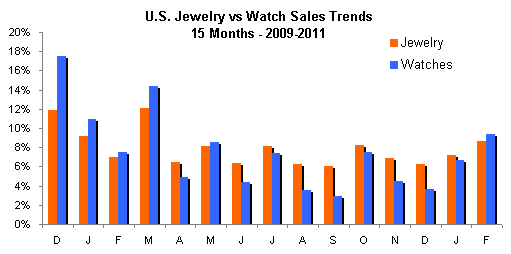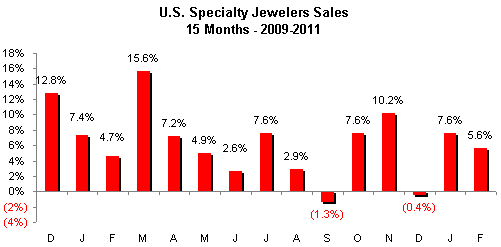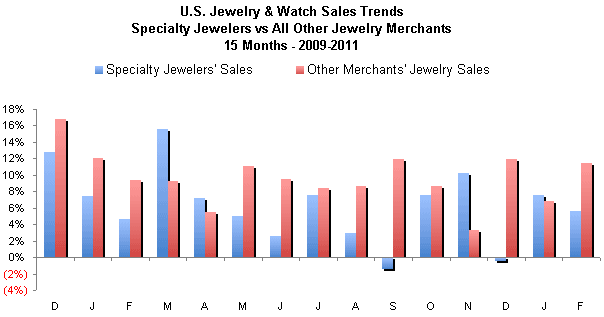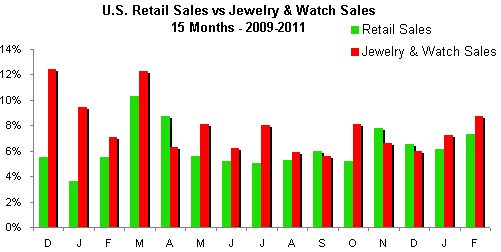IDEX Online Research: U.S. Watch Sales Gains Greater Than Jewelry (Full Analysis)
April 20, 11
(IDEX Online News) - In a major departure from long term historical trends, watch sales showed a greater gain in February than jewelry sales. Previously, jewelry sales gains have consistently been greater than watch sales gains every year since 2004. This trend reversed in February.
We believe that this is probably an anomaly related to the preliminary numbers. However, jewelry/watch producer Movado says its sales are expected to rise by 11%-13% this year, so perhaps this will be “the year of the watch.” We can make a case for continued weak watch demand, but the consumer holds the ultimate vote.
Total jewelry and watch sales were an estimated $5.6 billion in February 2011, up from the prior year’s $5.1 billion. Jewelry (only) sales represent about 89% of total industry sales, or an estimated $5.0 billion in February 2011.
The following graph summarizes monthly changes in sales for jewelry (red bar) and watches (blue bar) over the past fifteen months.

Source: US Dept of Commerce
Specialty Jewelers’ February Sales Show Moderate Gain
Specialty jewelers posted a solid 5.6% gain in February, based on preliminary data. Unfortunately, this gain was much more modest than the specialty jewelers’ January sales increase of 7.6% (revised). February is an important month for the jewelry industry: it is the third largest sales month for jewelers, driven by demand for Valentine’s Day jewelry.
In February, specialty jewelers’ sales were about $2.52 billion, up from last year’s $2.38 billion.
The graph below summarizes fifteen months of sales trends for specialty jewelers in the

Source: US Dept of Commerce
Specialty Jewelers Lost Market Share to Competitors
Specialty jewelers have been losing market share to other merchants who sell jewelry for over three decades. Typically, specialty jewelers lose market share in recessionary periods, and they never seem to regain this market share, even when the economy rebounds. We believe that this may be due to consumers’ quest for “value” – they believe that they can get a better deal on a day-to-day basis by shopping at discounters like Costco, Wal-Mart, and J.C. Penney than at specialty jewelers. An analysis of gross margins suggests that specialty jewelers tend to mark up their prices more than discounters and online merchants.
The graph below summarizes specialty jewelers’ sales versus jewelry sales at other merchants. While January was an exception to the long term trend – specialty jewelers took market share – sales trends in February indicated a return to the long term norm.
Specialty jewelers’ sales are shown by the blue bars, while other merchants’ jewelry sales are represented by the red bars.

Source: US Dept of Commerce
Jewelry Gained Share of Wallet in February
Jewelry took a modest share of consumer expenditures – also called “share of wallet” – in February, based on preliminary numbers. Longer term, we expect this trend to continue. Jewelry represents an industry with solid growth prospects, both in the
The graph below compares retail sales gains (ex-auto) to jewelry sales trends. Retail sales are show by the green bars, while jewelry and watch sales are represented by the red bars.

Source: US Dept of Commerce